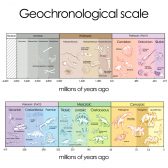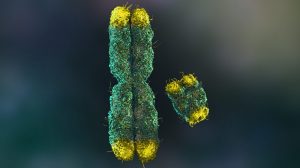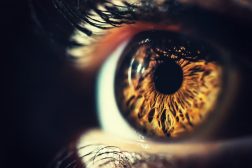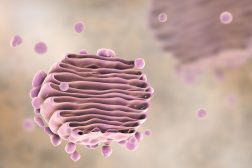Table of Contents
Definition
noun
plural: nucleoplasm
nu·cle·o·plasm, ˈnjuːklɪəˌplæzəm
(cell biology) The protoplasm of the nucleus comprised of various materials (e.g. chromosomes, nuclear bodies, and nuclear matrix) contained by the nuclear envelope
Details
Overview
In eukaryotic cell, the protoplasm is the cell’s living content. It consists of two major divisions: (1) the cytoplasm and (2) the nucleoplasm. The cytoplasm is the jelly-like substance of the eukaryotic cell comprised of the cytosol, the vesicles, the cytoskeleton, the inclusions and the organelles except for the nucleus. Thus, the cytoplasm of the eukaryotic cell is that part of the cell between the cell membrane and the nuclear envelope. The material contained inside the nuclear envelope is called nucleoplasm. The nucleoplasm is the protoplasm of the nucleus.
Features
The nucleus is the organelle responsible for maintaining the integrity of DNA and for controlling cellular activities such as metabolism, growth, and reproduction by regulating gene expression. The bilipid membrane of the nucleus is called the nuclear envelope. Inside the nucleus is the nucleoplasm that includes various nuclear materials, such as chromosomes, nuclear bodies, and nuclear matrix. The liquid portion of the nucleoplasm is referred to as the nucleosol (also called nuclear hyaloplasm), analogous to the cytosol of the cytoplasm.
Chromosomes are structures within the cell that bears the genetic material. They occur as threadlike linear strands of DNA bonded to various proteins inside the nucleus.
Nuclear bodies pertain to the non-membraned structures within the nucleus of the eukaryotic cell. They are prominent structures of non-chromatinic fibrillary material and mostly proteinaceous. They may be classified into simple (type I and type II) and complex (type III, type IVa, and type V). The nucleolus is one of the nuclear bodies characterized by being round and granular. It is composed of proteins, DNA, and RNA, and functions primarily for the creation of rRNA for ribosome assembly. Other examples of nuclear bodies are Cajal bodies and gems (Gemini of Cajal bodies), polymorphic interphase karyosomal association (PIKA) domains, promyelocytic leukaemia protein (PML) bodies, splicing speckles, paraspeckles, perichromatin fibrils, and clastosomes. Cajal bodies (0.3–1.0 µm in diameter) are nuclear bodies that resemble balls of tangled thread. The nucleus could contain one to ten Cajal bodies.1 Gemini of Cajal bodies(also called gems) derived its name from its semblance in size and shape of Cajal bodies, making them twins (Gemini). However, Gemini of Cajal bodies do not contain snRNPs (small nuclear ribonucleoproteins). Rather, they have SMN (survival of motor neuron) proteins. Furthermore, they are coilin-negative as opposed to Cajal bodies that are coilin-positive. PIKA domains whose functions are still unclear were first seen to be associated with chromatin.2 PML bodies are subnuclear structures that are spherical in shape, and in mammalian nucleus, occur in ten to 30 bodies with diameters ranging from 0.3 to 1 µm.1 They are comprised primarily of promyelocytic leukemia protein (PML) (hence, the name). Paraspeckles are irregularly-shaped subnuclear structures in the interchromatin space of the nucleus with a diameter ranging from 0.2 to1 μm in size.3 Their name is derived from being often in juxtaposed with splicing speckles, another subnuclear structures in the interchromatin regions. Splicing speckles (also called nuclear speckles, nuclear specks, splicing factor or SF compartments, interchromatin granule clusters, or B snurposomes) are involved in splicing snRNPs (thus, the name). Perichromatin fibrils are subnuclear fibrils rich in RNA. Clastostomes are ring-shaped nuclear bodies whose diameter ranges from 0.2 to 0.5 µm. They are comprised primarily of ubiquitin conjugates, proteolytically active 20S core and 19S regulatory complexes of the 26S proteasome, and protein substrates of the proteasome. Their number increases during proteasomal activity.4
The nuclear matrix is analogous to the cytoskeleton of the nucleus. It is a fibrillar network that provides structural support to the size and shape of the nucleus. It includes the nuclear lamina, which is the dense fibrous network juxtaposes the nuclear envelope.
Biological functions
The nucleoplasm is the site of various nuclear events and activities. For instance, it is where gene expression, DNA replication, and DNA repair occurs. Via the nucleolus, it also becomes the site of rRNA synthesis (for ribosome biogenesis). The presence of other nuclear bodies makes the nucleoplasm the site for transcriptional activities, e.g. mRNA splicing, small nucleolar RNA and small nuclear RNA maturation, histone mRNA maturation, polyadenylylation. The nuclear lamina in the nucleoplasm helps localize and organize the genetic information, especially during DNA replication and cell division.
Supplementary
Etymology
- Latin, diminutive of nucleus, meaning “kernel”
Synonyms
Further reading
Compare
See also
Reference
- Pollard, T., Earnshaw, W., Schwartz, J. & Johnson, G. (2008). Cell biology. Philadelphia, PA: Saunders/Elsevier.
- Saunders, W. S. (1991). Compartmentalization within the nucleus: discovery of a novel subnuclear region. The Journal of Cell Biology, 115(4), 919–931. https://doi.org/10.1083/jcb.115.4.919
- Paraspeckle. (n.d.). Wikipedia.org. Retrieved from https://en.wikipedia.org/wiki/Paraspeckle
- Lafarga, M., Berciano, M. T., Pena, E., Mayo, I., Castaño, J. G., Bohmann, D., Rodrigues, J. P., Tavanez, J. P., & Carmo-Fonseca, M. (August 2002). “Clastosome: a subtype of nuclear body enriched in 19S and 20S proteasomes, ubiquitin, and protein substrates of proteasome”. Molecular Biology of the Cell. 13 (8): 2771–82. doi:10.1091/mbc.e02-03-0122
© Biology Online. Content provided and moderated by Biology Online Editors







